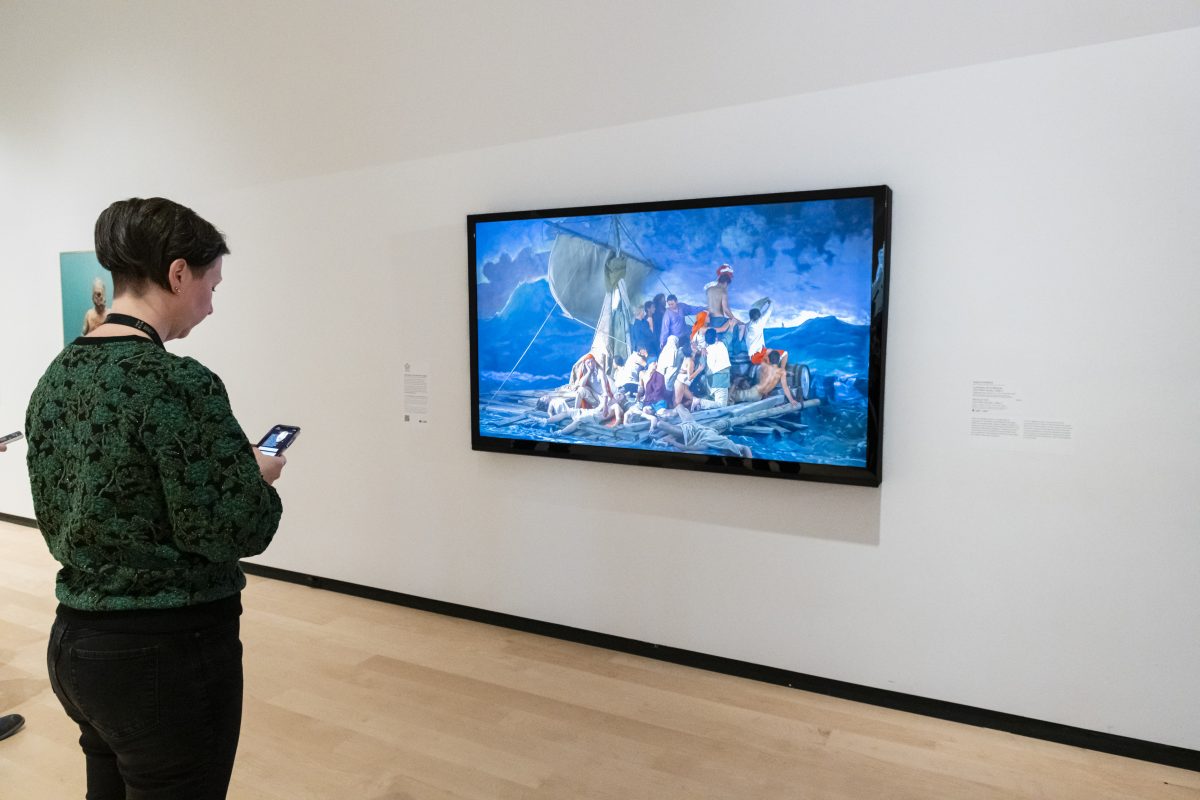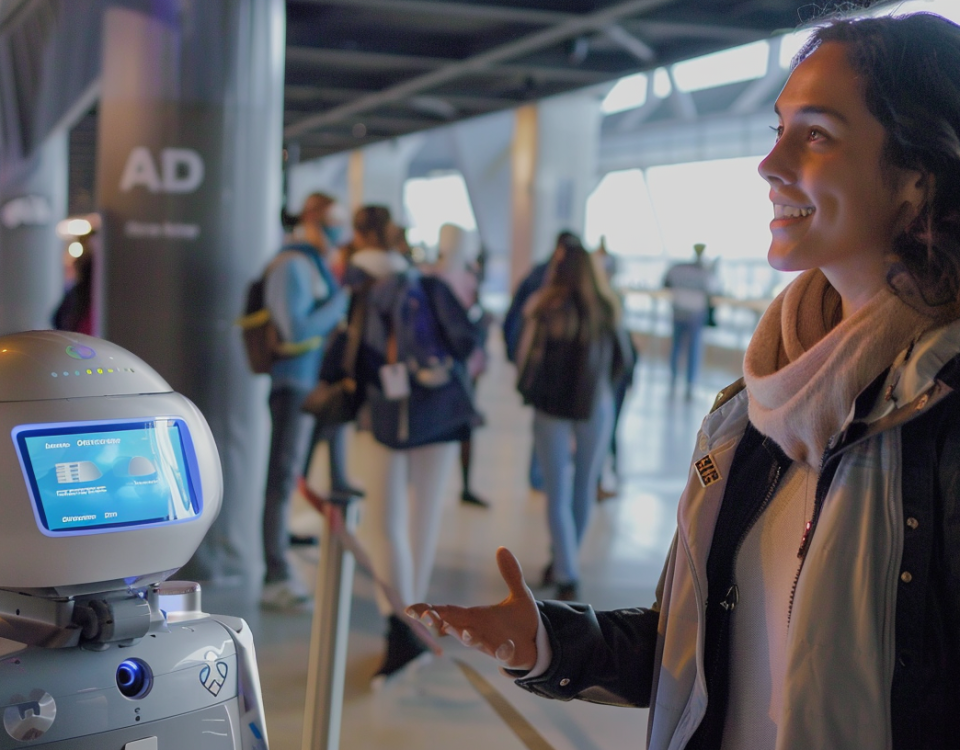
Conversational chatbots in tourism and culture: An essential tool
30/05/2024
Creation of the Expert Committee of the Artificial Intelligence and Tourism Working Group
06/06/2024Artificial intelligence (AI) is gradually (or all too quickly, depending on how you look at it!) transforming the way we interact with works of art. For several years now, I’ve been witnessing this technological revolution that is redefining the museum experience. At the Musée national des beaux-arts du Québec (MNBAQ), we had the opportunity to explore and experiment with AI by developing a conversational agent project. Here’s a look back at our generative adventure… of meaning 😉.
At the heart of each of our innovation projects at MNBAQ is the desire to design products, services, spaces or experiences that optimally meet the real needs of our visitors. It’s an approach known as human-centered design (Design Thinking) that the Museum has been experimenting with since 2020.
The Museum’s conversational agent project, commonly known as chatbot, is no exception and was developed in response to three questions and needs expressed by our visitors:
- How can I find what I like in the wide range of products you offer?
- How do I get in touch with a work of art?
- How can I find out more about the works that capture my attention?
Leveraging technologies such as generative artificial intelligence, natural language processing and machine learning, we have created a conversational agent that accompanies audiences, helping them to connect and spend more time with artworks.
Audiences can ask any questions they like, according to their interests and observations. They can learn to observe the works, understand the artist’s approach, and even share their feelings. A project developed as part of the Incubateur d’innovations muséales program, and made possible by a financial contribution from the Secrétariat à la Capitale-Nationale.
DEVELOPMENT IN PHASES

The development of such a system has enabled our teams to experiment with new technologies and acquire new skills, while at the same time getting to know our customers better. Agility was also an integral part of the project, and the team learned (and is still learning!) to adapt, learn and adjust at every stage of development.
In 2022, a first proof of concept was tested by nearly 80 Museum Members. They were invited to ask any questions they might have about BGL‘s work, Lost in Nature (The Car) . The aim of this first series of tests was to validate certain technological features, but also, and above all, the desirability of this type of device for our visitors.
This enabled us to identify areas for improvement, particularly in terms of natural language recognition and the interface, while at the same time garnering generally positive feedback on the concept. Indeed, participants reported that they were not shy about asking a robot their questions, and that this had enabled them to find out more about the work according to their own interests. What’s more, some said that the conversational agent had enabled them to establish a greater connection with the work and awaken their interest in a work that didn’t initially appeal to them.Wow 😊 Results that gave us wings!
THE CONTINUATION
In the light of the observations and comments compiled, we decided to pursue the development of the conversational agent. We worked with a new partner (allo AskMona!) and developed the concept in line with what we learned, and the new possibilities offered by technology.
In December 2023, we extended our scope of experimentation to include 10 works presented in the exhibitions. We and MNBAQ Collections. Contemporary art from Quebec. By the summer of 2024, we’ll have some forty works throughout the museum’s collections. Our new prototype is much easier to use, has a good sense of logic, a better general understanding of the issues and is able to make connections between people’s impressions and the factual information at hand.
EMOTIONS
Did you know that the time spent in front of a work in a museum varies between 3 and 15 seconds? Just… Surprising, isn’t it? Thanks to our conversational agent, tests have shown that visitors spend much more time contemplating a work of art.
Indeed, by asking all the questions that come to mind without embarrassment – and according to their interests and observations – they also learn to observe the works, understand the artist’s approach and even (and above all!) have a discussion about the emotions the work may arouse. This is where the magic of generative AI really comes into play. Because these elements are not scripted in advance and (despite everything!), the device remains benevolent and welcoming. What a surprise for our test teams 😉
THE FUTURE OF MUSEUMS

I’m deeply convinced that a conversational agent like the one developed at MNBAQ won’t replace the “human” guide. It’s just an additional offer to meet a different need for a different audience. It is essential to maintain a balance between the use of technology and the human experience, ensuring that AI does not replace contact between audiences and experience mediators, but complements it. But could AI replace traditional audio guides? Perhaps. Because it’s so individually tailored, it’s more in line with the expectations of today’s audiences – the personalized experience. The Museum’s conversational agent is welcoming: it recognizes the visitor’s individuality and diversity. It’s open: it lets you appreciate works from different angles (factual, historical, emotional, philosophical, etc.). He’s a caring person: he may suggest personalized itineraries based on the audience’s interests. It’s also unique in that it stands out for its distinctive approach.
AI can also play a crucial role in improving museum accessibility. For example, chatbots can be programmed to respond in multiple languages, enabling an international audience to take full advantage of exhibition-related content. What’s more, technologies such as voice recognition can be used to adapt tours to the specific needs of visitors, such as people with disabilities.
We’re only at the beginning of this digital revolution, which promises to profoundly transform the museum experience. The evidence is clear: technology enriches our understanding and appreciation of art. We must continue to explore the many possibilities open to us to make art and culture more accessible and engaging for as many people as possible.





